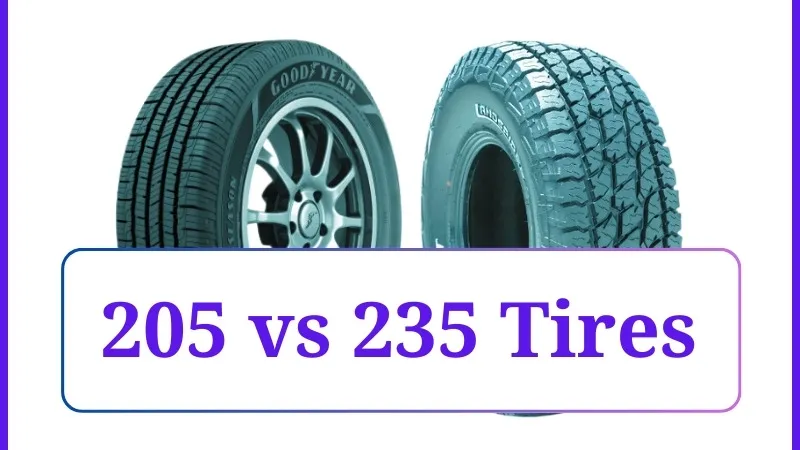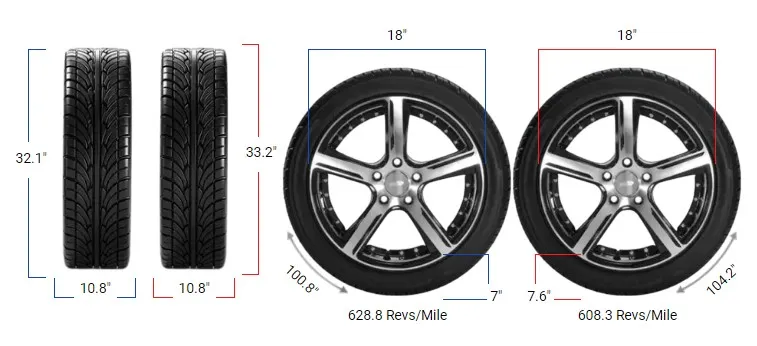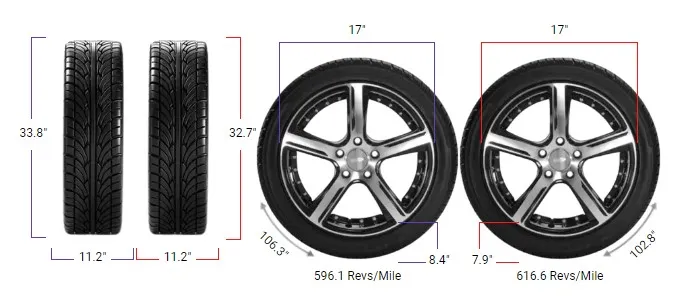205 vs 235 Tires

The key difference between 205 and 235 tires is their width. The 235 tires is about 30 mm wider than the 205 tires. The 205 tire has a width of 205 millimeters, while the 235 tire is 235 millimeters wide, giving the latter an additional 30 mm of width.
Although this may seem like a minor change, it can significantly impact your vehicle’s performance, including its traction, fuel efficiency, and handling characteristics.
The 235 tire provides a wider contact patch with the road, which typically results in improved traction and stability during cornering. This makes 235 tires more suitable for those looking for better handling performance, especially in high-speed or wet conditions.
However, the increased width also means higher rolling resistance, which can lead to slightly lower fuel efficiency. On the other hand, the 205 tire offers a narrower contact patch, which reduces rolling resistance and improves fuel economy, making it ideal for those who prioritize efficient driving.

Fitment Guide
Before deciding to switch between 205 and 235 tires, it’s important to ensure that the tires are compatible with your vehicle’s rims. Below is the Ideal Rim Width Range for both tire sizes:
- 205 tire: Compatible with rims that are 6.0 to 7.5 inches wide.
- 235 tire: Suitable for rims ranging from 7.0 to 8.5 inches wide.
In this case, 205 and 235 tires are both compatible with rims 7.0 to 7.5 inches wide, making it possible to switch without changing the rims.
Also the aspect ratio and rim diameter must remain the same, or the difference in the overall diameter must be within 3% to maintain speedometer accuracy and ensure proper vehicle handling. If these conditions are not met, switching tire sizes may adversely affect performance and safety.

On-Road Performance
Handling and Stability: The 235 tire offers better stability and cornering ability due to its increased width. The larger contact patch provides more grip, which is beneficial when navigating tight turns or driving at higher speeds. This improved traction also makes 235 tires ideal for those who enjoy a sportier driving experience or require additional stability in challenging road conditions.
On the other hand, 205 tires have a narrower profile, which allows for lighter steering and better maneuverability, especially in urban environments. The reduced rolling resistance also contributes to a more responsive feel, making 205 tires ideal for drivers who prefer a more effortless and predictable driving experience.
Fuel Efficiency: The 205 tire is more fuel-efficient compared to the 235 tire due to its narrower width, which reduces rolling resistance. This lower resistance allows the vehicle to maintain speed with less effort, ultimately leading to lower fuel consumption. If fuel economy is your main priority, 205 tires are a great option.
In contrast, the 235 tire has a larger contact patch, which increases rolling resistance, thereby decreasing fuel efficiency. This trade-off is worth considering if you value traction and stability over maximizing fuel economy.
Ride Comfort: When it comes to ride comfort, 235 tires generally provide a smoother experience because of the wider contact area, which helps absorb bumps and uneven surfaces more effectively. This makes 235 tires an excellent choice for long highway drives or rougher roads where comfort is a priority.
However, 205 tires may offer a firmer ride but tend to generate less road noise, especially at moderate speeds. The narrower profile helps create a quieter cabin, which might be more desirable for drivers seeking a peaceful and calm driving environment.

Off-Road Performance
Traction on Loose Surfaces: For off-road driving, 235 tires provide superior traction on loose surfaces such as gravel, sand, or mud.
The wider contact patch distributes the vehicle’s weight more evenly, reducing the likelihood of getting stuck and providing more stability when navigating challenging terrains. On the other hand, 205 tires can offer better maneuverability on trails that require precision.
The narrower profile allows the tire to dig into loose surfaces more effectively, making it suitable for those who need to navigate tight paths or rocky terrain. Depending on the type of off-road driving, either tire size could be advantageous.

Speedometer Impact
Switching between 205 and 235 tires can also impact the accuracy of your vehicle’s speedometer and odometer. Changes in tire diameter can cause discrepancies in speed and distance readings.
If the 235 tire has a larger overall diameter compared to the 205 tire, the speedometer may display a lower speed than the actual speed, resulting in inaccurate readings.
To ensure accuracy, it may be necessary to recalibrate the speedometer if the overall diameter difference exceeds 3%. Proper calibration helps maintain reliable performance metrics and ensures that you have accurate information while driving.
Benefits of 235 Tires:
- Improved Traction and Stability: The wider contact patch enhances grip, particularly during cornering and in wet conditions.
- Smoother Ride: The wider profile absorbs road imperfections better, resulting in a smoother ride on rough roads.
- Better Off-Road Capability: The larger footprint offers improved flotation on loose surfaces, making 235 tires suitable for off-road driving.
Drawbacks of 235 Tires:
- Reduced Fuel Efficiency: Increased rolling resistance may lead to lower fuel economy, especially in city driving.
- Higher Road Noise: The wider tire can generate more road noise, which may be noticeable at higher speeds.
Benefits of 205 Tires:
- Better Fuel Economy: The narrower width reduces rolling resistance, resulting in improved fuel efficiency, ideal for daily commuting and highway driving.
- Easier Maneuverability: The lighter steering feel makes 205 tires easier to handle, particularly in urban environments.
- Reduced Road Noise: The smaller contact patch can lead to less road noise, contributing to a quieter driving experience.
Drawbacks of 205 Tires:
- Less Traction: Compared to 235 tires, 205 tires have a smaller contact area, which can reduce traction, especially in wet or high-speed driving conditions.
- Less Comfortable Ride: The narrower profile may not absorb road imperfections as effectively, resulting in a firmer ride.

Difference Between 205 and 235 Tires
The main difference between 205 and 235 tires is the width. 235 tires are 30mm wider than 205 tires, impacting handling, stability, and overall vehicle performance.
Can I Use 205 Tires Instead of 235?
Yes, it is possible to use 205 tires instead of 235 tires, as the ideal rim width range for 205 tires (6.0-7.5 inches) overlaps with that of 235 tires at 7.0 and 7.5 inches. However, the narrower tires may not provide optimal performance.
It’s vital to weigh certain aspects carefully too. Specifically, ensure new tires have the same aspect ratio and rim diameter as your current set. Any difference in overall diameter should not exceed 3% to avoid affecting speedometer readings and vehicle dynamics.
Can I Use 235 Tires Instead of 205?
Yes, you can use 235 tires instead of 205 tires. The ideal rim width range for 235 tires (7.0-8.5 inches) overlaps with that of 205 tires at 7.0 and 7.5 inches, ensuring compatibility. Also, bear in mind these crucial considerations.
Replacement tires need to match your current aspect ratio and rim diameter. Any variation in overall diameter should stay within 3% to avoid compromising speedometer accuracy and vehicle handling.
Can You Put 205 Tires on 235 Rims?
Yes, you can put 205 tires on rims designed for 235 tires. The overlapping ideal rim widths at 7.0 and 7.5 inches ensure proper fitment.
Can You Put 235 Tires on 205 Rims?
Yes, it is possible to put 235 tires on rims designed for 205 tires, as they share ideal rim widths at 7.0 and 7.5 inches. However, using wider tires on narrower rims may affect handling and tire wear.
Our Observation
The decision between 205 and 235 tires ultimately depends on your driving priorities and preferences. If you value fuel efficiency, maneuverability, and a quieter ride, 205 tires are likely the best choice for you.
On the other hand, if you need enhanced traction, stability, and a smoother ride, 235 tires are a better option. Always ensure that the rim compatibility and overall diameter requirements are met to maintain optimal safety and performance.



